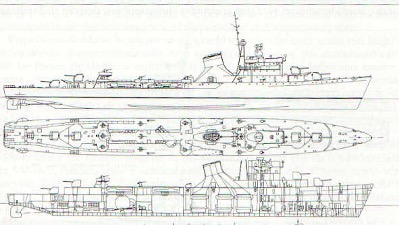Before and during WW2, the Regia Marina developed a certain number of designs for destroyers and cruiser that however never entered service due to the start of the war and the dire situation in which Italy found itself during the conflict. In this article, I provide an overview on the main projects for which we have data and info from reliable sources.
Comandanti Medaglio d’Oro class
In 1942, after two years of clashes on the seas and sacrifices to protect the convoys directed to North Africa, the Regia Marina was in desperate need of destroyers and escort ships to replace the losses and older ships (like the WW1 era torpedo boats). In addition, the modern destroyers built in the 30s had demonstrated to have some issues: limited range, engine reliability, weak AA armament and stability issues with rough seas.
Some of the problems originated from the fact that these ships were designed for other roles and partly due to the strong focus on speed, which meant sacrificing other characteristics. In late 1942 the Regia Marina approved the construction of 24 (later 20) new destroyers of a completely new design.
They were wider (12 m) and longer (120 m) than the precedent Soldati class, the main armament consisted of four 135/45 mm guns (model 1937-1938) in single (the same guns equipping the Capitani Romani class cruisers and the Duilio class battleship ps), torpedo armament consisted of 6×533 mm tubes. The AA armament was made up of 12×37 mm Breda cannons (the previous Soldati class had 8×20 mm cannons).
The new destroyers of this class, named “Comandanti Medaglia d’Oro” class or just “Comandanti” class, were larger and heavily armed ships which would have performed well in the kind of war that the Regia Marina was fighting in the Mediterranean.

Design of the Comandanti class destroyers
However, their construction started between the end of 1942 and the spring of 1943, but by this time the tide had already turned in favour of the Allies in the Mediterranean.
The loss of Tunisia, the invasion of Sicily and the armistice of September 1943 put a final halt to this project. Nine uncompleted hulls were found by the Germans abandoned in the shipyards of Livorno and Sestri Levante.
One of them was launched in 1944 by the Germans but was never completed and later sunk by air raids.
Etna class
In 1938 the Royal Thai Navy commissioned the construction of two brand new light cruisers to the CRDA shipyards of Trieste. The ship’s specifications were similar to those of the early “Condottieri” cruiser, displacing 5.500 tons and armed with 152 mm guns (in three twin mountings) and also had 6×533 mm torpedo tubes.
When Italy declared war on France and Britain in June 1940, the delivery of the ships (still not completed) to Thailand became a very unlikely eventuality and so the Regia Marina decided to size the vessels in December 1941.
By 1942, the Regia Marina was lacking destroyers and escort ships, desperately needed to escort the vital troop and supply convoys to North Africa. In summer 1942 the Navy approved the conversion of the two vessels into antiaircraft cruisers, to be renamed Etna (ex Taksin) and Vesuvio (ex Naresuan). The conversion plan envisaged the replacement of the main 152 mm guns with the 135/45 mm guns (model 1937-1938).

Launch of the Naresuan in August 1941
The torpedo tubes from the original project would have been removed while the AA armament would have consisted of 10 Ansaldo 65 mm guns in single mounts. These guns had been long-awaited by the Regia Marina but delays in their development slowed the overall adoption of these systems.

The conversion project of the Etna class
These guns were also going to equip the aircraft carrier Aquila, under construction in Genova.
The conversion of the two ships, both launched in summer 1941, was never completed and they were scuttled in Trieste after the armistice to prevent capture by the Germans. Refloated after the end of the war, they were scrapped in 1950.

The hulls of Vesuvia and Etna near a torpedo boat in Trieste’s harbour
Costanzo Ciano class
The last pre-war naval programme of the Regia Marina (1938-1939) envisaged the construction of two additional Littorio class battleships and twelve scout-cruiser of the Capitani Romani class and 16 ocean-going submarines.
This programme also envisaged the creation of the so-called “break out fleet” (Flotta d’ evasione), aimed at operating in the oceans and harassing enemy maritime routes there. The plan was quite unrealistic but nevertheless envisaged the construction of some new cruisers (of 8.000-9.000 tons), that would have operated from bases in Italian East Africa.
These ships were named the Costanzo Ciano and Venezia but never went beyond the design phase.
The main armament would have remained the same as on the Duca degli Abruzzi class (10×152/52 guns mod.1934). The most radical improvement was instead the AA armament, improved to 8 OTO 90 mm guns in single armoured mounts, the same AA weapons equipping Littorio and Duilio class battleships.
On the web, there are some contradicting draws and designs on how they would have looked like, so we will hardly know the truth about this project.


Design drawings of the Ciano class cruisers
Sources
Bagnasco, E. (2005). In guerra sul mare.
Stille, M. (2021). Italian destroyers of WW2.
Mezzi storici, Marina Militare Italiana (marina.difesa.it)
Ct classe Comandanti, (www.regiamarinaitaliana.it)
The Regia Marina “Costanzo Ciano” light cruisers (https://stefsap.wordpress.com/2015/11/04/the-regia-marina-costanzo-ciano-light-cruisers/)